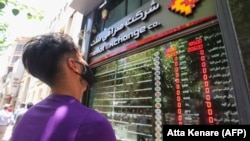Reports from Iran say that that the value of Iranian currency rial has fallen to a record low June 22, as the U.S. dollar traded at the open markets in Tehran for 200,000 rials or even more.
This could be the biggest devaluation of Iran's national money since records have started.
However, while some Iranian websites have said that the rate of exchange for the U.S. dollar was 199,900 rials for a few hours on Monday morning 22 June, the decline in the value of rial has been continuing throughout the day.
Meanwhile, the rate of exchange for euro set a new record of 224,000 rials on Monday. At the same time, the value of a standard gold coin went as high as 844,000,000 rials and reaching the 900,000,000 peak around mid-day.
Iranians on social media have been posting sarcastic comments in criticism of the government all Monday. @Mohsen Ahmadian wrote on Twitter: "What is more frightening than the 200,000 rials per dollar rate, is that we are going to feel happy after the rate comes down to 180,000 rials."
Another Twitter user writing under the alias @Patrick_jane77 wrote: "The bazaar in Tehran is half closed. Many shops do not sell anything and even refuse to quote the prices of what they sell. Those who give you a quote, make it known that prices are valid for only one hour. Or they quote prices in dollars. And still some idiots believe that the country will progress under the Islamic Republic."
And @Drx66q1 asked: "Where the hell is the man who said the United States cannot do a damn thing?" This is a slogan that Supreme Leader Ali Khamenei likes to repeat now and then.
Meanwhile, @mojaban posted a picture of the 1979 Iranian revolutionaries whose revolution was hijacked by the mullahs and said: "We owe the 200,000 rials per dollar exchange rate to you."
Monday morning, the governor of the Central bank of Iran (CBI) Abdolnasser Hemmati and the Minister of Economy Farhad Dezhpasand were summoned to the Iranian Parliament (Majles) to explain the situation.
Hemmati attributed the most recent decline in the value of the Iranian currency to the impact of the COVID-19 pandemic on the economy, as well as the recent IAEA board of governor's resolution against Iran. However, he promised that the economy would recover soon, but did not say how.
Still many Iranians believe that the government is manipulating the exchange rate, by devaluating its own currency to earn money when sells dollars and euros to bridge its budget shortfall.
The rise in the price of gold and the rates of exchange gained a new momentum following the IAEA resolution about punitive measures against Tehran. Prices had already been on the rise for several weeks but the new development regarding Iran's nuclear program led to a major surge as economists had predicted earlier.
Hemmati had tried to rule out the prediction and wrote in a commentary that the CBI will provide the foreign currency needed by businesses at the right price. He warned that "the psychological atmosphere created by the IAEA resolution should not lead people in the market to take it as a wrong signal."
At the same time, it appears that Iran is facing a decline in its foreign currency reserves. The International Monetary Fund has predicted that Iran's foreign currency reserves will fall to $85 billion this year with a $19.4 billion decline. The IMF further predicted that the figure will reach $69 billion next year with a further 16 percent fall.
On Sunday, President Hassan Rouhani promised to reveal the identity of those who have taken foreign currency at a preferential rate from the government but have not returned what they owed to the banking system.
He also attributed the situation of foreign exchange in Iran to the coronavirus pandemic and the obstacles in repatriating Iran's oil money from other countries.
The United States left the nuclear agreement with Iran in 2018 and imposed sanctions on Tehran and implemented a maximum pressure policy against Iran, accusing it of destabilizing the region, supporting terrorism, and developing ballistic missiles.
Subsequently, according to Iranian Vice-President Es'haq Jahangiri Iran's oil revenues dropped from $100 billion to $8 billion last year. Meanwhile, Iran's non-oil exports declined by 35 percent in the winter of 2018 and another 48 percent during the winter of 2019.
Jahangiri criticized U.S. sanctions last week as the biggest cause of Iran's economic problems. Nevertheless, a few days later he promised to the Prime Minister of Syria to send even more resources.





